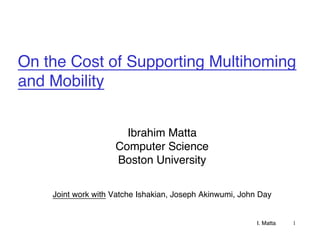
On the Cost of Supporting Multihoming and Mobility in RINA vs LISP vs Mobile IP
- 1. On the Cost of Supporting Multihoming and Mobility Ibrahim Matta Computer Science Boston University Joint work with Vatche Ishakian, Joseph Akinwumi, John Day I. Matta 1
- 2. Mobility = Dynamic Multihoming Hosts / ASes became increasingly multihomed Multihoming is a special case of mobility RINA (Recursive InterNetwork Architecture) is a clean-slate design RINA routing is based on node addresses µ Late binding of node address to point-of-attachment Compare to LISP (early binding) and Mobile-IP Average-case communication cost analysis Simulation over Internet-like topologies I. Matta
- 3. Whatʼs wrong today? Applications Web, email, ftp, … Applications Transport Transport Network Network Network 12 7.2 8. Data Link DL DL Data Link 19 .12 7. 5 8.10 15 Physical PHY PHY Physical .1 12 128.197.0.0 www.cs.bu.edu 128.10.0.0 128.197.15.10 We exposed addresses to applications We named and addressed the wrong things
- 4. RINA offers better scoping Applications Web, email, ftp, … Applications Transport TCP, UDP, … Transport IPC Network IP Network Network Data Link DL DL Data Link IPC IPC Physical PHY PHY Physical E2E (end-to-end principle) is not relevant µ Each IPC layer provides service / QoS over its scope IPv6 is/was a waste of time! µ We donʼt need too many addresses within an IPC layer
- 5. RINA: Good Addressing Bob want to send message to “Bob” A “Bob”B B To: B I1 I2 Destination application is identified by “name” App name mapped to node name (address) Node addresses are private within IPC layer µ Need a global namespace, but not address space µ Destination application process is assigned a port number dynamically 5
- 6. RINA: Good Addressing Bob want to send message to “Bob” A B To: B IPC processes I1 I2 on same machine BI2 Late binding of node name to a PoA address PoA address is “name” at the lower IPC level Node subscribes to different IPC layers 6
- 7. RINA: Good Routing source destination Back to naming-addressing basics [Saltzer ʼ82] µ Service name (location-independent) node name (location-dependent) PoA address (path-dependent) path We clearly distinguish the last 2 mappings Route: sequence of node names (addresses) Map next-hopʼs node name to PoA at lower IPC level I. Matta 7
- 8. Mobility is Inherent MH CH Mobile joins new IPC layers and leaves old ones Local movement results in local routing updates 8
- 9. Mobility is Inherent CH Mobile joins new IPC layers and leaves old ones Local movement results in local routing updates 9
- 10. Mobility is Inherent CH Mobile joins new IPC layers and leaves old ones Local movement results in local routing updates 10
- 11. Compare to loc/id split (1) Basis of any solution to the multihoming issue Claim: the IP address semantics are overloaded as both location and identifier LISP (Location ID Separation Protocol) ʻ06 EIDx -> EIDy EIDx EIDy RLOC1x RLOC2y EIDx EIDy Mapping: EIDy RLOC2y I. Matta
- 12. Compare to loc/id split (2) Ingress Border Router maps ID to loc, which is the location of destination BR Problem: loc is path-dependent, does not name the ultimate destination EIDx -> EIDy RLOC1x RLOC2y EIDx EIDy Mapping: EIDy RLOC2y
- 13. LISP vs. RINA vs. … Total Cost per loc / interface change = Cost of Loc / Routing Update + ρ [Pcons*DeliveryCost + (1-Pcons)*InconsistencyCost] ρ: expected packets per loc change Pcons: probability of no loc change since last pkt delivery RINAʼs routing modeled over a binary tree of IPC layers: update at top level involves route propagation over the whole network diameter D; update at leaf involves route propagation over D/2h, h is tree height I. Matta
- 14. LISP I. Matta
- 15. LISP I. Matta
- 16. RINA I. Matta
- 17. RINA I. Matta
- 18. RINA I. Matta
- 19. MobileIP I. Matta
- 20. LISP vs. RINA vs. … 8x8 Grid Topology RINA uses 5 IPC levels; on average, 3 levels get affected per move LISP RINA I. Matta
- 21. Simulation: Packet Delivery Ratio RINA BRITE generated 2- level topology Average path length 14 hops Random walk LISP mobility model I. Matta 21
- 22. Simulation: Packet Delay LISP RINA I. Matta 22
- 23. Bottom Line: RINA is less costly RINA inherently limits the scope of location update & inconsistency RINA uses “direct” routing to destination node More work: prototyping I. Matta
- 24. Thank You Questions? I. Matta